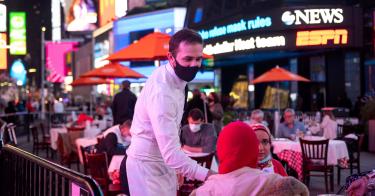The unemployment rate fell by one percentage point to 6.9% as the economy added 638,000 jobs in October, the Bureau of Labor Statistics reported Friday.
This incredibly strong report comes in well above expert predictions and signals that if states continue to safely reopen their economies and schools, we will continue to gain back the economic losses from COVID-19.
In October, 2.2 million more Americans were employed compared to September, reflecting the sixth straight month that the economy has added jobs and the unemployment rate has fallen.
An additional 724,000 Americans jumped back into the workforce, lifting the labor force participation rate by 0.3% and dropping the U-6 unemployment rate—which measures both the unemployed who are looking actively for a job and those who are unemployed but not actively seeking work—from 12.8% to 12.1%.
>>> What’s the best way for America to reopen and return to business? The National Coronavirus Recovery Commission, a project of The Heritage Foundation, assembled America’s top thinkers to figure that out. So far, it has made more than 260 recommendations. Learn more here.
Unemployment rates declined across the board in October. The rate was 6.7% for adult men, 6.5% for adult women, 13.9% for teenagers, 6% for whites, 10.8% for blacks, 7.6% for Asians, and 8.8% for Hispanics.
In addition, the number of Americans temporarily laid off fell by 1.4 million to 3.2 million—down from a high of 18.1 million in April. The number of permanent job losses continues to hover around 3.7 million jobs.
The Bureau of Labor Statistics continued to track changes in the labor force since the onset of COVID-19. They report that 21.2% of those employed teleworked, down slightly from 22.7% in September.
In addition, 15.1 million Americans said they still have less work—either fewer hours or no work at all—because their employer closed or lost business. And about 3.6 million not in the labor force were prevented from looking for work due to the pandemic.
Here are some of the largest gains and losses for October:
Leisure and hospitality: +271,000 jobs (food services and drinking places accounted for 192,000 of those gains)
Professional and business services: +208,000 jobs
Retail trade: +104,000 jobs
Construction: +84,000 jobs
Health care and social assistance: +79,000 jobs
Transportation and warehousing: +63,000 jobs
Manufacturing: +38,000 jobs
Financial activities: +31,000 jobs
Government: -268,000 jobs (159,000 jobs in local and state government education, and 109,000 jobs in temporary census workers)
It’s common sense that the measures taken to prevent the spread of COVID-19 rocked our economy. Many Americans understandably are nervous about returning to certain activities.
But as we continue to learn more, and to develop and employ new safety measures, states that give their citizens greater freedom to make their own choices about which activities they will and won’t resume are faring relatively well.
My Heritage Foundation colleague Rachel Greszler writes that over 50 million children attend public elementary and secondary schools in the U.S., and over 70% of households with school-age children have each parent in the household working.
Knowing that, it makes sense that America cannot fully recover until parents have the option to send their kids back to school. Greszler also mentions that because of the substantial evidence showing schools have not been superspreaders of COVID-19, it’s quite safe for children to return to school with proper safety measures in place.
In previous months, we’ve advocated a safe reopening. And judging by the numbers of the October jobs report, we are seeing the fruit of this labor.
However, several states continue to hold back on reopening. This is not only harming our economy; it’s potentially causing life-long consequences for children not attending schools.
For state and local policymakers who are driving the decisions affecting everyday Americans’ lives, the message is clear: Saving lives and livelihoods go hand-in-hand; trust Americans to exercise their freedoms and don’t hold back opportunities.
Continue being smart, continue being safe. Our country depends on it.
This piece originally appeared in The Daily Signal



